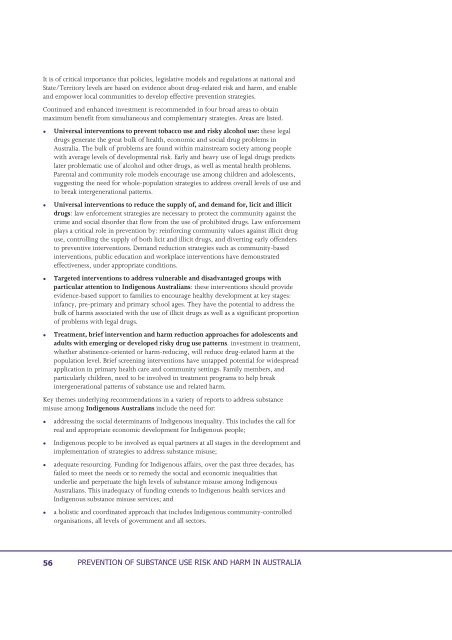Summary - Department of Health and Ageing
Summary - Department of Health and Ageing
Summary - Department of Health and Ageing
Create successful ePaper yourself
Turn your PDF publications into a flip-book with our unique Google optimized e-Paper software.
It is <strong>of</strong> critical importance that policies, legislative models <strong>and</strong> regulations at national <strong>and</strong><br />
State/Territory levels are based on evidence about drug-related risk <strong>and</strong> harm, <strong>and</strong> enable<br />
<strong>and</strong> empower local communities to develop effective prevention strategies.<br />
Continued <strong>and</strong> enhanced investment is recommended in four broad areas to obtain<br />
maximum benefit from simultaneous <strong>and</strong> complementary strategies. Areas are listed.<br />
<br />
<br />
<br />
Universal interventions to prevent tobacco use <strong>and</strong> risky alcohol use: these legal<br />
drugs generate the great bulk <strong>of</strong> health, economic <strong>and</strong> social drug problems in<br />
Australia. The bulk <strong>of</strong> problems are found within mainstream society among people<br />
with average levels <strong>of</strong> developmental risk. Early <strong>and</strong> heavy use <strong>of</strong> legal drugs predicts<br />
later problematic use <strong>of</strong> alcohol <strong>and</strong> other drugs, as well as mental health problems.<br />
Parental <strong>and</strong> community role models encourage use among children <strong>and</strong> adolescents,<br />
suggesting the need for whole-population strategies to address overall levels <strong>of</strong> use <strong>and</strong><br />
to break intergenerational patterns.<br />
Universal interventions to reduce the supply <strong>of</strong>, <strong>and</strong> dem<strong>and</strong> for, licit <strong>and</strong> illicit<br />
drugs: law enforcement strategies are necessary to protect the community against the<br />
crime <strong>and</strong> social disorder that flow from the use <strong>of</strong> prohibited drugs. Law enforcement<br />
plays a critical role in prevention by: reinforcing community values against illicit drug<br />
use, controlling the supply <strong>of</strong> both licit <strong>and</strong> illicit drugs, <strong>and</strong> diverting early <strong>of</strong>fenders<br />
to preventive interventions. Dem<strong>and</strong> reduction strategies such as community-based<br />
interventions, public education <strong>and</strong> workplace interventions have demonstrated<br />
effectiveness, under appropriate conditions.<br />
Targeted interventions to address vulnerable <strong>and</strong> disadvantaged groups with<br />
particular attention to Indigenous Australians: these interventions should provide<br />
evidence-based support to families to encourage healthy development at key stages:<br />
infancy, pre-primary <strong>and</strong> primary school ages. They have the potential to address the<br />
bulk <strong>of</strong> harms associated with the use <strong>of</strong> illicit drugs as well as a significant proportion<br />
<strong>of</strong> problems with legal drugs.<br />
Treatment, brief intervention <strong>and</strong> harm reduction approaches for adolescents <strong>and</strong><br />
adults with emerging or developed risky drug use patterns. investment in treatment,<br />
whether abstinence-oriented or harm-reducing, will reduce drug-related harm at the<br />
population level. Brief screening interventions have untapped potential for widespread<br />
application in primary health care <strong>and</strong> community settings. Family members, <strong>and</strong><br />
particularly children, need to be involved in treatment programs to help break<br />
intergenerational patterns <strong>of</strong> substance use <strong>and</strong> related harm.<br />
Key themes underlying recommendations in a variety <strong>of</strong> reports to address substance<br />
misuse among Indigenous Australians include the need for:<br />
<br />
<br />
<br />
<br />
addressing the social determinants <strong>of</strong> Indigenous inequality. This includes the call for<br />
real <strong>and</strong> appropriate economic development for Indigenous people;<br />
Indigenous people to be involved as equal partners at all stages in the development <strong>and</strong><br />
implementation <strong>of</strong> strategies to address substance misuse;<br />
adequate resourcing. Funding for Indigenous affairs, over the past three decades, has<br />
failed to meet the needs or to remedy the social <strong>and</strong> economic inequalities that<br />
underlie <strong>and</strong> perpetuate the high levels <strong>of</strong> substance misuse among Indigenous<br />
Australians. This inadequacy <strong>of</strong> funding extends to Indigenous health services <strong>and</strong><br />
Indigenous substance misuse services; <strong>and</strong><br />
a holistic <strong>and</strong> coordinated approach that includes Indigenous community-controlled<br />
organisations, all levels <strong>of</strong> government <strong>and</strong> all sectors.

















